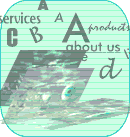
|
Fun or folly with fonts; going easy on graphics 7.
Playing with typefaces is fun but amateurish Choose
typefaces that are compatible with most platforms or use one or
two alternative fonts in the HTML tags. You can use Arial, which
is available in most Windows operating systems, and add Helvetica
for Macintosh. Better still but not on bandwidth is convert your
fonts into bitmaps (gif or jpeg) to make sure they display correctly
on all platforms. HTML-assembled
tables and the single pixel gif lend some, however unwieldy, control
over the layout of text (and other elements) on the page. This is
in the domain of the web graphic designer cum coder. Basic principles
in print design such as white spaces, claustrophobic pages, text
contrasts, kerning, indenting and the likes can now be applied even
on web pages. Even
if you are not a graphic designer who is usually picky about types,
learn more about typography. It will help you appreciate its contribution
to readability and aesthetics. 8. Pictures are worth a thousand words
You
can reduce the number of words, and the number of eyestrain, to
explain ideas using photos or illustrations. For instance, instead
of just describing your new formula for hair growth and using too
many word about the outcome of using it continuously for three (3)
months, put “before and after” photos to show what you
mean. The ultimate goal of processing all graphics for the Web is balancing download speed which is tied to file size and aesthetics. This process is referred to as optimization.
Optimizing graphics for the Web involves conversion to web-compatible formats such as gifs, jpegs and pngs, which formats to use for which graphics and how to compress them to an optimal file size. The physical size of your image is as important. The largest image you can display for most monitors without scrolling is 640 x 480 pixels.
A substantial speed gain can be achieved with color reduction. Instead of using all 24-bit (true-color) images, settle for 8-bit, web-safe colors except for images that have smooth gradations. And, don’t ever use more than 72 dots per inch resolution. Higher ones are only for those destined for print and other media.
|

| Introduction |
| Passion for beauty |
| Ten ways you can do now |
| Analyze and then draw |
| Don't overlook bandwidth, web-safe colors |
| Fun or folly with fonts; going easy on graphics |
| Showing a friendly site; jumping on rich media (?) |
| Moving on...no matter what! |